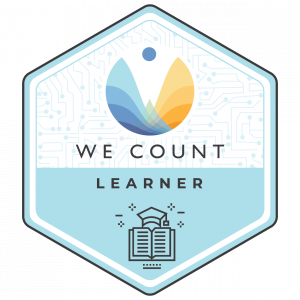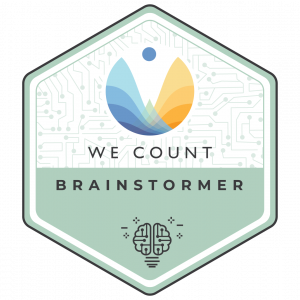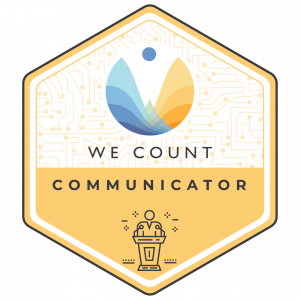Badges
Badges enabled people to showcase their proficiency in the growing fields of AI, data systems and inclusive data practices as well as other skills. Badges, once earned, belonged completely to the earner and could be shared across social media platforms, such as LinkedIn and Instagram, to display their achievement and showcase what was learned. These badges were designed to address the interests, skills and availability of diverse participants. People worked with and learned from a range of experts:
- Industry and public service professionals in data systems
- Technical and research assistants who specialized in data science
- Inclusive design facilitators with expertise in inclusive co-design
The badges fell under a variety of categories, such as Learner, Brainstormer, Collaborator and Communicator, and could be undertaken independently or together as part of a continuing project:
- Learner badge allowed the recipient to show off their knowledge without a comprehensive assessment.
- Brainstormer badge demonstrated that the earner had helped We Count discover or outline solutions and approaches to in-house initiatives and inclusive design challenges.
- Collaborator badge demonstrated that the earner had participated in a co-creation or co-research activity.
- Communicator badge demonstrated that earners had delivered presentations, project reports and visualizations of findings culminated in earlier phases of a challenge activity.
Earning a badge

We Count badges were earned by registering with and participating in We Count initiatives or challenges and completing assessments. Badges could be “stacked” to earn new badges.
Our initiatives and their corresponding badges are listed below.
Sentiment Analysis Workshop

Learner badge
You learned:
- How small organizations and their members could complete a sentiment analysis and build their own data set that represented a concern of the disability community as part of our learning
- The process and the tools involved in the data ecosystem, as well as how to become a part of the data ecosystem
Designing Proof and Evidence with Minorities and Outlier Data

Learner badge
You learned:
- How evidence-based decisions fell short of meeting the needs of marginalized, highly diverse communities
- The challenges of producing proof for a highly diverse group of small minorities and outliers who are marginalized
- How the passage of policy changes to Medical Assistance in Dying (MAID), Bill C7, was devaluing the lives of persons with disabilities by singling out this group as not requiring a foreseeable death in order to access MAID

Brainstormer badge
You brainstormed:
- Acceptable forms of evidence, proof and data that could be produced by a highly diverse group of small minorities and outliers who are marginalized
- Alternative strategies and tools for minorities to collect and provide this evidence to policy makers
AI and Disability: A Double-Edged Sword

Learner badge
You learned:
- The risks and rewards of AI for people with disabilities
- How future developments in different industries could impact the disability community
The Metric Society and the Unmeasurable

Learner badge
You learned:
- How the rise of quantification had created and strengthened social hierarchies
- How quantification could lead to standardization but does not necessarily capture social diversity and deviance
- About the importance of bottom-up, community-driven initiatives in addressing the top-down mismanagement of personal data and access to social services
Building Indigenous Future Imaginaries

Learner badge
You learned:
- How various Indigenous communities are contributing to AI technology to express and preserve their identity
- How Indigenous ways of knowing are contributing to the global conversation regarding society and AI
Inclusive AI for HR

Learner badge
You learned:
- How AI in hiring systems impacted the employment of people with disabilities
- How to better develop AI-based hiring systems that are inclusive and transparent for people with disabilities
AI Hiring System Policies

Learner badge
You learned:
- How legal frameworks and public policies could act against structural discrimination in candidate selection on the basis of disability
- About the challenges to policy regulations for AI hiring systems
AI Employment Systems

Learner badge
You learned:
- How new innovative technology solutions could potentially mitigate hiring biases for people with disabilities
- How the “normative behaviour” screening is harming people with disabilities
AI and AT Apps

Learner badge
You learned:
- How AI systems within various commercial software applications impact persons with disabilities and marginalized communities
- About accessibility features and design considerations present in current assistive technology applications
- By sharing your experience with technology in an AI-supported world in a succinct and organized format

Brainstormer badge
You brainstormed:
- By using cases of AI in assistive technology apps to evaluate how they impacted persons with disabilities and marginalized communities
- By exploring various accessibility features and design considerations present in current AI-powered mobile application technology

Communicator badge
You communicated:
- Your enthusiasm and support in discussing AI in society and the implications for persons with disabilities and other groups
- A basic understanding of accessibility and usability in presentation documents using Microsoft Office or G Suite
- Your ability to synthesize qualitative data based on the content from the previous Brainstormer badge within a presentation
Bias In, Bias Out

Learner badge
You learned:
- How predictive algorithms and data mining affected different populations in a discriminatory manner
- How specific data resources were used to train and reinforce machine learning models to produce biased outputs